Bowflex Ultimate 2 User Manual
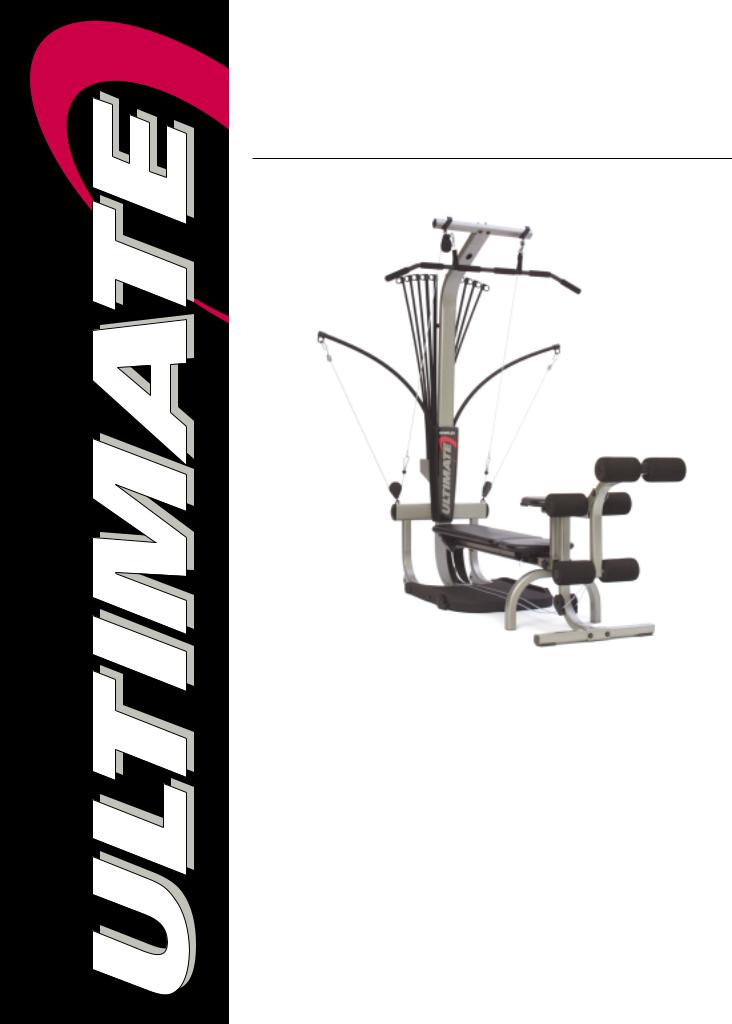
®
BOWFLEX®
Owner’s Manual
Fitness&Guide
Written By: Tom Purvis RPT, RTS
Registered Physical Therapist
and founder of the Resistance Training Specialist Program
Special Edition Includes:
Dr. Ellington Darden’s
Six Week Fast Fat Loss — Body Leanness Program
BOWFLEX®
FITNESS
Table of Contents
Getting To Know Your Machine |
1 |
Using Your Machine |
2 |
About Your Bowflex Attachments |
8 |
Safety |
9 |
Defining Your Goals |
10 |
Exercising Properly |
12 |
The Workouts: |
|
The 20 Minute Better Body Workout |
13 |
Advanced General Conditioning |
13 |
20 Minute Upper / Lower Body |
14 |
Body Building |
15 |
Circuit Training Anaerobic / Cardiovascular |
16 |
True Aerobic Circuit Training |
17 |
Strength Training |
18 |
Chest Exercises: |
|
Bench Press |
19 |
Chest Fly |
19 |
Incline Bench Press |
20 |
Decline Bench Press |
21 |
Resisted Punch |
21 |
Lying Cable Crossover |
22 |
Flat Barbell Bench Press |
22 |
Shoulder Exercises: |
|
Seated Shoulder Press |
23 |
Front Shoulder Raise |
23 |
Rear Deltoid Rows |
24 |
Standing Lateral Shoulder Raise |
24 |
Seated Lateral Shoulder Raise |
25 |
Scapular Protraction |
25 |
Scapular Depression |
26 |
Shoulder Rotator Cuff — INTERNAL ROTATION |
26 |
Shoulder Rotator Cuff — EXTERNAL ROTATION |
27 |
Shoulder Extension |
27 |
Shoulder Shrug |
28 |
Barbell Shoulder Shrug |
28 |
Lying Front Shoulder Raise |
29 |
Reverse Fly |
29 |
Military Press |
30 |
Back Exercises: |
|
Lying Shoulder Pullover |
31 |
Wide Pulldowns |
31 |
Narrow Pulldowns |
32 |
Lying Lat Pulldowns |
32 |
Lying Narrow Lat Pulldowns |
33 |
Low Back Extensions |
33 |
Seated Lat Rows |
34 |
Lying Lat Fly |
34 |
Reverse Grip Pulldowns |
35 |
Scapular Retraction |
35 |
Stiff Arm Pulldown |
36 |
Barbell Bent Over Row |
36 |
Arm Exercises: |
|
French Press |
37 |
Lying Triceps Extension |
37 |
Lying 45 Degree Triceps Extension |
38 |
Triceps Pushdown |
38 |
“Rope” Pushdowns |
39 |
Single-Arm Pushdown |
39 |
Cross Triceps Extension |
40 |
Triceps Kickback |
40 |
Seated Triceps Extension |
41 |
Standing Biceps Curl |
41 |
Seated Biceps Curl |
42 |
Seated Wrist Extension |
42 |
Standing Wrist Extension |
43 |
Seated Wrist Curl |
43 |
Standing Wrist Curl |
44 |
Reverse Curl |
44 |
Lying Biceps Curl |
45 |
Reverse Grip Barbell Curls |
45 |
Barbell Curls |
46 |
Abdominal Exercises: |
|
Seated (resisted) Abdominal Crunch |
47 |
Seated (resisted) Oblique Crunch |
47 |
Reverse Crunch |
48 |
Resisted Reverse Crunch |
48 |
Trunk Rotation |
49 |
Abdominal Crunch |
49 |
Leg Exercises: |
|
Leg Extension |
50 |
Leg Curl |
50 |
The Squat |
51 |
Leg Press |
51 |
Lying (Prone) Leg Curl |
52 |
Standing Hip Extension |
52 |
Standing Hip Flexion |
53 |
Seated Leg Curl |
53 |
Lying Leg Extension |
54 |
Seated (straight Leg) Calf Raise |
54 |
Standing Leg Kickback |
55 |
Kneeling Leg Kickback |
55 |
Standing Hip Abduction |
56 |
Seated Hip Adduction |
56 |
Seated Hip Abduction |
57 |
Ankle Inversion |
57 |
Ankle Eversion |
58 |
Deadlift |
58 |
Stiff-Leg Deadlift |
59 |
Fast Fat Loss Now |
|
The Bowflex Body Leanness Program |
|
By Dr. Ellington Darden |
60 |

Getting To Know Your Machine
CONGRATULATIONS on your commitment to fitness! By choosing Bowflex to be your partner, you’ve chosen a machine that can deliver on its promises!
The resistance and aerobic training that can be performed on the Bowflex is unmatched by any other single piece of home fitness equipment available. You have definitely made the right decision!
In this owner’s manual you’ll find detailed information on a wide variety of exercises, workout programs and a very specialized program titled, “Fast Fat Loss Now” by Dr. Ellington Darden.
Please take your time to read through the entire manual before attempting to use your Bowflex. It’s important you understand HOW to properly perform each exercise before you attempt to perform the exercise with Power Rod® Resistance.
With all of the fitness choices available today, we understand that choosing a piece of equipment can be very confusing. Everyone at Bowflex, Inc. would like to thank you for your trust and your confidence in our product. Bowflex is as good as we say it is, and you’re just about to prove it to yourself.
Again, thank you for choosing Bowflex.
THE BOWFLEX ULTIMATE
Cable Storage
Rod Caps 

Cable 
Rod Box
Pulley Frame
Adjustable 
Pulley System
Pulley
Hand Grip/
Ankle Cuff
Foot Rest
Standing/ Squat

Platform
Spring Lock
Seat Pin 
Lat Bar Rests
 Lat Bar
Lat Bar
 Power Rods®
Power Rods®
 Cable Hook
Cable Hook
 Vertical Main
Vertical Main
Frame
Bench
 Leg Attachment
Leg Attachment
 Seat
Seat
 Seat Rail
Seat Rail
Bench Legs
Leg Extension/Leg
Curl Attachment
1

|
|
Using Your Machine |
|
Power Rod |
® |
Resistance |
When You Are Not Using |
|
|
||
Your Bowflex
Power Rods are made from a special composite material. Your rods are sheathed with a protective black rubber coating. Each rod is marked with its weight rating on the rod cap.
Adjusting And Understanding The Resistance
The Bowflex Ultimate comes with 310 pounds of resistance (one pair of 5-pound rods, two pairs of 10pound rods, one pair of 30-pound rods, and two pairs of 50-pound rods). If you upgraded to a 410 pound capacity, you will have an additional pair of 50-pound Power Rods.
Hooking The Power Rods® To The Cables:
You may use one rod or several rods in combination, to create the desired resistance level. To hook multiple rods up to one cable, simply bend the closest rod toward the cable and place the cable hook through the rod cap. Then, hook up the next closest rod.
Hooking up the most forward rod prevents rods from crossing over the top of one another.
Disconnect the cables from the Power Rods when you are not using your Bowflex.
Use the rod binding strap included with your machine to bind all the rods together
near the top. This keeps them neat in appearance and makes your Bowflex as compact as possible. Place your cables and grips through the strap to keep them out of the way.
To upgrade to 410 pounds of Power Rod® Resistance please call 1-800-269-3539
2
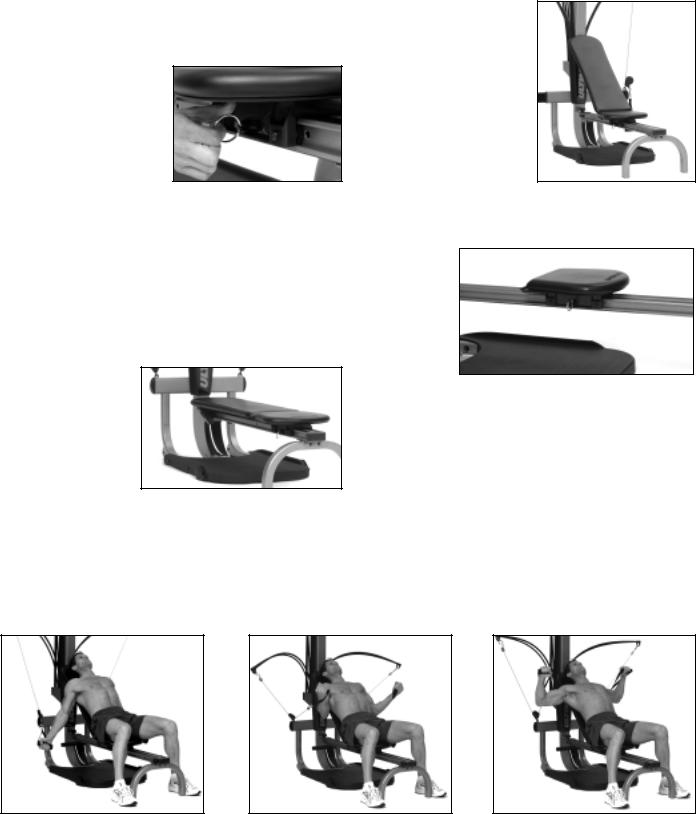
Using Your Machine
The Workout Bench
Your Bowflex has four different bench positions. To adjust the bench, simply locate the spring lock pin on the side of the seat. Pull out pin to release seat, then slide it to the desired position. Pull out
pin, give it half a turn, and release to place it in a “free sliding” position for exercises such as rowing.
Quick Release Bench: The long portion of your bench attaches to and releases from the seat portion very easily. To attach it, simply insert the half hinge on the end of the bench into the half hinge on the seat. For standing exercises, simply remove the bench by lifting up on the long portion and pulling away from the seat.
Flat Position 1 & 2: Along the side of the seat rail there are three holes for the spring lock seat pin. Pull out on the pin and slide the entire bench forward until the spring lock seat pin locks into a hole.
With the bench in the flat position there are two possible holes for the spring lock pin to lock into, one forward and one back.
Incline Position: Start with the bench flat in the the furthest position away from the Power Rods®. Pull out
on the spring lock seat pin and lift the long bench pad up. Slide forward until the pin locks into the farthest forward hole. Rest the bench’s incline support bracket on the base of the Power Rods®.
“Free Sliding” Position: Remove the long bench pad. Pull out on the spring lock seat pin, give it a half turn, and release to place
it in a “free sliding” position for exercises such as rowing.
How to Mount the Bowflex Incline Bench
Sit on the bench and reach back, one arm at a time, grasping hand grips. KEEPING HANDS DOWN AND PALMS UP.
Curl your hands up toward the front of your shoulders AND turn your wrists so that your palms now face away from you. The cables will now be over your elbows.
Begin by reaching back for hand grips. |
Curl up toward your shoulders. |
Turn your wrists forward. |
3

Using Your Machine
Using the Bowflex
Hand Grips
The Bowflex hand grips can be used as regular grips, hand cuffs or ankle cuffs.
Regular Grip: Grasp the handle and cuff together to form a grip without inserting your hand through the cuff portion. Most of the exercises you perform utilize this grip.
Hand Cuff Grip: Slip your hand through the cuff portion of the grip so that the foam pad rests on the back of your hand. Then grasp the remainder of the grip that is
sitting in your palm. This method of gripping is great for exercises like front shoulder raises or any exercise where your palm is facing down.
Ankle Cuff Grip: The cuff opening can be made larger to accommodate the ankle. Simply insert your hand in the cuff and slide it away from the handle. Insert your foot or ankle and tighten the grip by
sliding the handle back toward the cuff.
Using the Bowflex
Leg Press Belt
The Leg Press Belt is used exclusively for the Leg Press and the Seated Hamstring Curl exercises.
•With the Bowflex seat adjusted to the “free sliding” position (spring lock seat pin unlocked), the hand grips removed, and the
desired amount of resistance hooked up, sit on the seat and position the leg press belt around your hips.
•Slide forward to the pulleys and place your feet through the right and left openings under the pulleys.
•Attach the belt to the cables and cinch the adjustment strap on the belt by pulling the strap until the belt is taut.
•Place hands on vertical main frame and push yourself back while placing feet, one at a time, onto non-skid pads on pulley frame.
•Grasp belt near where it’s attached to the cables and begin to press back.
Grips manufactured under license agreement with Hands-On Sports & Gym Accessories Inc. Patent # 4756527
4
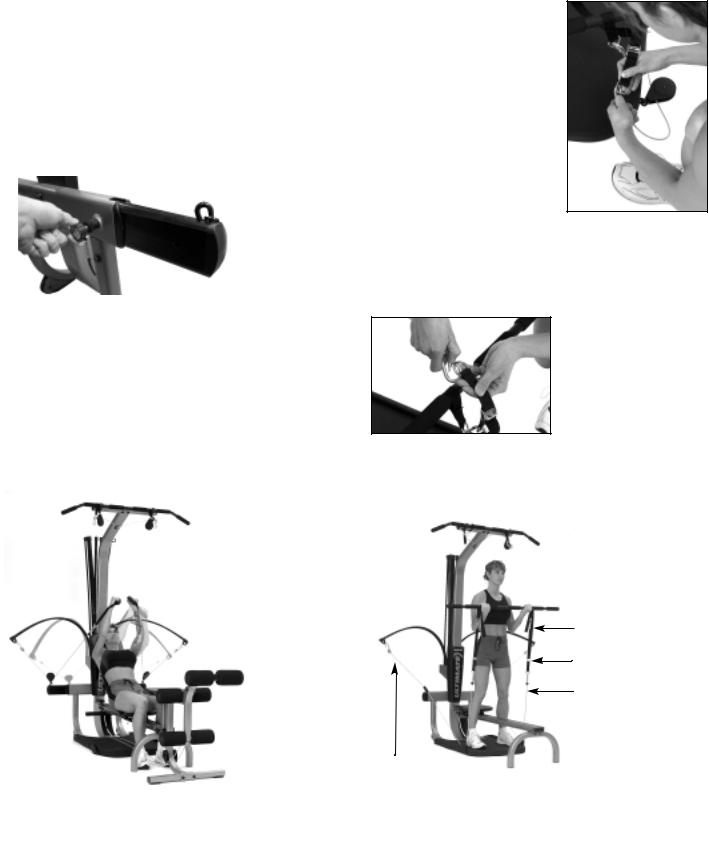
Using Your Machine
Using the Bowflex
Adjustable Pulley System
Using the Bowflex adjustable pulley system is as easy as pulling a pin and expanding the pulley out.
Pulley knobs are spring-loaded and are located on the back of the adjustable pulley system. To extend the pulley, simply twist the knob a couple of turns to the left, then pull out. Next, pull the adjustable sleeve out away from the machine until it clicks into the extended position. Then, tighten the knob to lock the adjustable pulley into position.
|
|
The adjustable |
|
|
pulley system was |
|
|
designed to |
|
|
change the angle |
|
|
of resistance to |
|
|
increase the |
|
|
effectiveness of |
|
|
many upper body |
|
Pulleys adjust position with the simple turn and |
|
|
exercises. |
|
|
pull of a knob. |
|
|
|
|
Use the pulley system in either the wide or narrow pulley position. We’ve included a guide in each exercise so you can use the pulley at the correct position.
To avoid injury, do not attempt to use the pulley in the wide position when the manual indicates to perform the exercise in the narrow pulley position.
Make certain the adjustable pulley system is locked and secure before adding any Power Rod resistance to the pulley.
Exercises in the wide position may require a
lighter weight than those in the narrow position.
The Bowflex Ultimate adjustable pulley system allows you to work the same muscles from different angles, depending on the width of the pulley angle.
Using the Bowflex
Low Pulley/Squat Station
Connect the low pulley/squat station with the squat cables.
Without any resistance attached, thread the squat cables through the low pulley. The black plastic ball on the cable should rest directly against the pulley and should be on the far side of the pulley, away from the machine.
The squat cable has a loop at the end. Fasten the loop with a snap hook to the rod cables.
Next, fasten the squat cables to
the squat harness, using a snap hook.
And finally, attach the squat harness to the squat bar using a snap hook.
Now you can add Power
Rod Resistance.
|
|
Squat Harness |
|
|
Adjustment Buckle |
|
|
Squat Cables |
|
|
|
|
|
Hooking up the low pulley/squat |
|
|
station is easy. Once it’s |
|
|
together, you can use it for a |
|
|
wide variety of exercises — |
Rod Cables |
||
|
|
including squats, flat bench |
|
||
|
|
presses and bent over rows! |
|
|
|
5
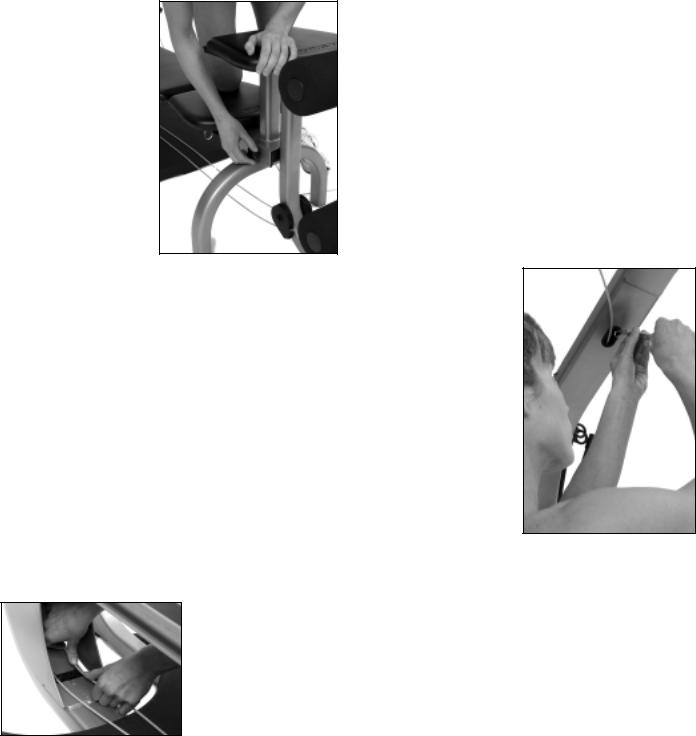
Using Your Machine
Using the Bowflex
Leg Extension/Leg Curl
Attachment
The Bowflex leg extension/leg curl attachment is a gymquality attachment that helps you develop strong, muscular legs.
Attaching the leg extension/leg curl attachment is as easy as screwing in two knobs.
With all Power Rod resistance off and with the bench in the incline position, move the attachment to the end of the sliding seat rail.
The leg extension/leg curl attachment uses two knobs to attach to the Bowflex, at the end of the sliding seat rail.
Remove the knobs from the attachment and place the attachment over the end of the seat rail. Line up the holes and screw the knobs in. Make certain the attachment is secure before sitting on it and before adding weight to the cables.
Using a snap hook, attach the loops at the end of the leg attachment cables to the rod cables. Once this is accomplished, you are ready to add Power Rod resistance to the attachment.
To set up for leg curls, simply remove the quick release bench and place it onto the hinge of the leg extension/leg curl seat.
Using The Bowflex
Lat Tower
Build back and shoulder muscles quickly with this integrated lat tower. It is easy to set up and can get you on track in no time at all.
To attach the tower, remove all Power Rod resistance. Be certain the lat bar is secured to the lat bar rests. Remove the lat tower cables from their storage holes, and let them dangle from the lat bar.
Using a snap hook, attach the loop from the lat tower cables to the rod cables. Again, check that lat bar is secured on the lat bar rests. Now you can add Power Rod resistance.
If you choose to use hand grips rather than the lat bar for exercises, remove all Power Rod resistance from the lat tower prior to exchanging the bar for hand grips.
When not in use, lat tower cables store easily in storage hole in the lat tower. Simply push the cables into the hole, so they’re out of sight and out of the way.
When not in use, leg extension/leg curl cables can be stored in clips located directly under the Power Rods, along the path of the sliding seat rail.

Using Your Machine
Folding & Moving
Your Bowflex
Folding and moving your Bowflex is easy. Follow the simple steps below to fold your Bowflex. Once it’s folded, simply tilt the machine back on its transport wheels and roll it to any location
1.Remove the leg attachment from the Bowflex, if attached.
2.Lock the seat and bench into place using the spring lock seat pin.
3.Hook cables into cable storage loops.
4.Bind the Power Rods® with the rod binding strap.
5.Remove the threaded knob on the platform.
6.Tilt the bench up to the Power Rods®.
7.Screw the threaded knob into the end of the sliding seat rail.
Maintenance & Care Of Your Bowflex:
Your Bowflex requires very little maintenance. To keep your Bowflex in top condition check all fasteners and rod caps before each workout and tighten as needed.
Clean the bench with a non abrasive cleaner after each use. This will keep it looking new. Any non abrasive household cleaner or soap works well. Many automotive interior cleaners make surfaces too “slick” and should not be used.
If you have any questions regarding maintenance please call our customer service department at 1-800-269-3539.
1 |
|
2 |
|
|
|
3 |
|
4 |
|
|
|
|
|
|
5 |
|
6 |
|
|
|
|
|
|
8
7
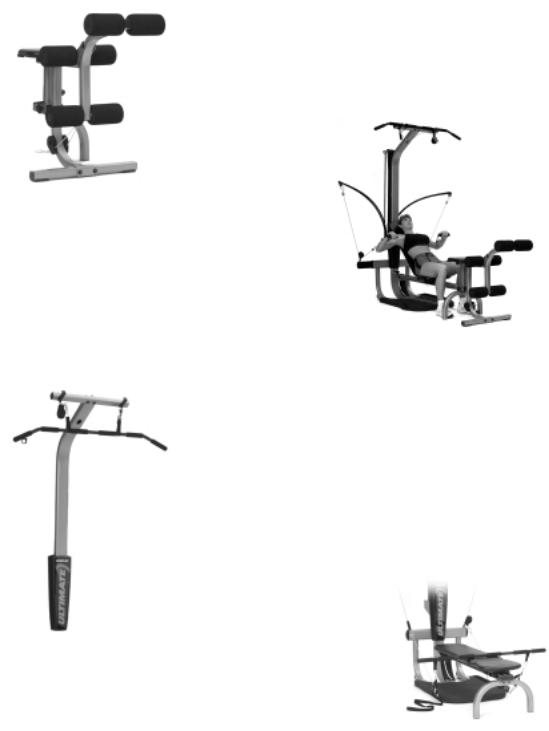
About Your Bowflex Attachments
The Bowflex Leg Extension / Leg Curl Attachment
This attachment is designed to add more effectiveness to all exercise routines where “leg work” is required.
Safety
•Before using the attachment, make sure all fasteners are in place and tightened.
•Make sure the attachment's cables are securely fastened to the regular Bowflex cables.
•Always use the supplied threaded knobs to secure the attachment to your Bowflex.
The Bowflex Lat Pulldown
The lat pulldown tower enhances several exercises that work the back and triceps muscles.
Safety
•Before using the lat tower, make sure all fasteners are in place and tightened.
•Make sure the cables are securely fastened to the regular Bowflex cables.
•Always use the “Bar Holders” to support the lat pulldown bar or remove the bar when not in use.
•Do not hang from the lat tower and do not attempt to do chin ups from the bar.
•Never pull on the bar or handle unless there is resistance attached to it.
The Adjustable
Pulley System
This attachment is specifically designed to enhance the bench press and shoulder press exercises by changing the angle of resistance. The attachment is mounted on the rear of the machine and serves to widen the angle of resistance to create a more effective exercise. To use the adjustable pulley system, first remove any Power Rod resistance. Then unscrew the pin on the back and pull it out slightly until you can slide the pulley away from the machine. Slide the pulley only until it clicks into place and then push the pin forward to lock it into place. Make certain the pins are completely locked in place before you use the adjustable pulley system.
Safety
•Before using the attachment make sure all fasteners are in place and tightened.
•Always check fasteners, hooks, cables and
each workout to ensure functioning.
The Low Pulley/
Squat Station
Use this station to do squats, bent over rows and more. Exercises performed here work your legs and most of your other lower body muscles. Plus you can use it for serious upper body workouts, too!
Safety
•Always wear shoes with non-skid soles when using the low pulley/squat attachment.
•Always adjust cable travel and tension of the squat harness in such a manner that it will not cause a hazard.
•Always check fasteners, snap hooks, cables and pulleys before each workout to ensure proper functioning.
8

WARNING!
Before beginning any exercise program consult your physician or health care professional. Only he or she can determine the exercise program that is appropriate for your particular age and condition. If you experience any lightheadedness, dizziness, or shortness of breath while exercising, stop the exercise and consult your physician.
For Your Safety
Please Follow These Instructions
•Keep your body weight centered on the machine, bench, or standing platform while exercising.
•When using the Bowflex for standing leg exercises, always grasp the Power Rods® for stability.
•Keep out of the path of the Power Rods® when exercising and make certain that observers also stand clear of the Bowflex when the Power Rods® are in use.
•Never move or adjust the bench while sitting or lying on the Bench. Never stand on the bench.
•Before exercising, make sure the spring lock seat pin is securely fastened and the bench is firmly in place.
•Inspect your machine before each workout. Periodically check all fasteners to make sure none have loosened with use. Tighten if necessary.
•When hooking up Power Rods® do not stand directly looking over the top of the rods. Stand off to the side while attaching rods.
•Never attempt to exercise with more resistance than you are physically able to handle.
•Keep cables and Power Rods® bound with the rod binding strap when the Bowflex is not in use.
•Make sure adjustable pulley system’s adjustment pins are securely tightened before use.
9
Defining Your Goals
Your body will do what you train it to do. That’s why it’s important to define your goals and focus on those goals. Here are some fitness components that will help you define your goals and choose your fitness program.
MUSCLE STRENGTH is the maximum force you can exert against resistance at one time. Your muscle strength comes into play when you pick up a heavy bag of groceries or lift a small child. It is developed when a localized muscle is worked both positively (concentric) and negatively (eccentric) at a resistance great enough to perform only five to eight repetitions of the exercise before the muscle fails. Each set of repetitions is followed by a rest interval that typically runs three times longer than the set. Later, between exercise sessions, the muscle overcompensates for the stress and usually increases in both strength and size.
MUSCLE ENDURANCE is the ability to perform repeated contractions. It comes into play when you cross-country ski or work on your feet all day. Endurance training addresses the slow twitch, endurance muscle fibers, which depend on oxygen for energy. To develop muscle endurance, use low resistance and high repetitions — about 15-20 repetitions in each set, three sets to each exercise, working the muscle only to fatigue.
MUSCLE POWER is the combination of strength and speed of the muscular contraction. This is often misinterpreted as:
a)Being directly associated with certain skill or sport and/or
b)Meaning that you must move fast.
Load is actually a more important factor than speed when attempting to improve power. When training to achieve muscular power, pick a resistance that fatigues you in the 3- 5 repetition range. When performing these reps, it is more important to think of contracting the muscles faster rather than attempting to move faster. Performing sport simulation exercises usually results in a deterioration of the motor pattern or skill. The biomechanically sound method of improving power in your sport is to train for power using the correct joint movements, as described in this manual. Then practice the skill associated with your sport, learning to apply this newly achieved power.
BODY COMPOSITION is the ratio of fat weight (fat) to lean weight (muscles, bones and tissue). As you age, the ratio shifts. The fat weight increases and the lean weight decreases. Training for muscle strength will generally increase muscle size and aerobic conditioning will help burn extra calories. Performing these two forms of exercise, either at different times or together, will create the greatest changes in body fat weight.
BALANCED STRENGTH and alignment is the result of equal strength developed in all parts of the body. It comes into play in your standing and sitting posture, and in your ability to perform just about any activity safely and effectively. An over-development of the back will round the shoulders; weak or stretched abdominals can cause lower back pain. You want a balance of muscle strength in front and back. In addition, you need a balance of strength between your middle, lower, and upper body.
FLEXIBILITY is the ability of a muscle or group of muscles to move the joint through a full range of motion. Flexibility comes into play when you execute an overhand serve or stretch for the top shelf in the kitchen. It is a cooperative movement of opposite muscle groups. When a muscle contracts, its opposite muscle group must relax for the action to occur. Increased flexibility means an increased range of motion, made possible by this simultaneous contracting and relaxing. Good flexibility is important in protecting the body from injury and can be achieved through the balanced strength training programs included in this manual.
CARDIOVASCULAR ENDURANCE is the ability of the heart and lungs to supply oxygen and nutrients to exercising muscles over an extended period of time. It comes into play when you jog a mile or ride a bike. It is a critical component of overall fitness and health. Any exercise program must be supplemented with cardiovascular training, such as rowing on the Bowflex.
10
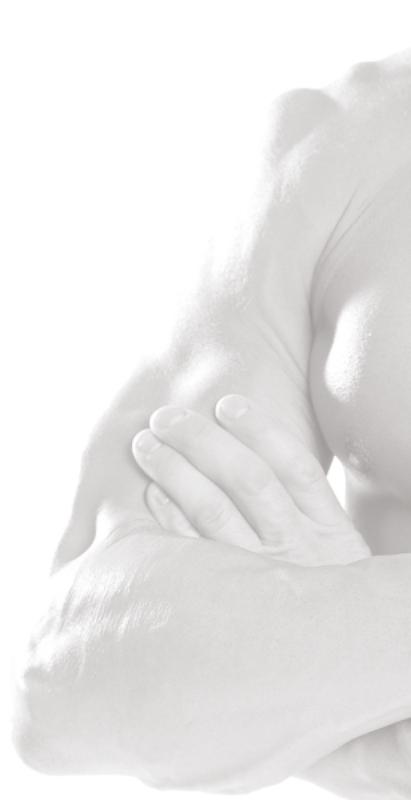
Defining Your Goals
Reaching Your Goals
To reach your goals you must follow a consistent, well designed program that provides balanced development to all parts of the body and includes both aerobic and strength exercise. Only then will you meet your goals safely and efficiently.
The workout routines found in this manual are professionally designed and written to target specific fitness goals. Should you not find one specific program to your liking, you can design your own, based on sound information and the principles found in this manual.
Designing Your Own Program
You may want to design your own personal program specifically geared to your goals and lifestyle. Designing a program is easy, as long as you follow these guidelines.
Understand fitness and its components: Improperly designed programs can be dangerous. Take some time to review this manual as well as other fitness guides.
Know your current fitness level: Before you start any fitness program you should consult a physician who will help you determine your current abilities.
Identify your goals: Goals are critical to choosing and designing an exercise program that fits and enhances your lifestyle, but so is strategy. It’s important not to rush the process and try to accomplish too much too soon. That will lead to setbacks and discouragement. Instead, set a series of smaller achievable goals.
Select complementary exercises: Be sure to pair exercises that address compound joint movements and single joint movements. In addition, select exercises that address complementary muscle groups.
Put first things first: During each session, first work those muscle groups that need the most training.
Remember your cardiovascular component: Any fitness program must contain a cardiovascular fitness component to be complete. So complement your resistance training with aerobic exercise such as walking, running, bicycling or rowing on the Bowflex.
Training variables: When designing your own program there are several variables that, when mixed properly, will equal the right fitness formula for you. In order to find the best formula, you must experiment with several combinations of variables. The variables are as follows:
•Training Frequency: The number of times you train per week. We recommend daily activity but not daily training of the same muscle group.
•Training Intensity: The amount of resistance used during your repetition.
•Training Volume: The number of repetitions and sets performed.
•Rest intervals: The time you rest between sets and the time you rest between workouts.
Once you’ve established a base of fitness, follow these basic principles:
•Isolate muscle groups: Focus work on specific muscle groups.
•Progressive Loading: The gradual systematic increase of repetitions, resistance and exercise period.
11

Exercising Properly
Working Out
A workout begins in your mind’s eye. With concentration and visualization you can approach your workout with a positive, constructive attitude. A good pre-workout mental routine is to sit and relax, so you can focus on what you are about to do and think about achieving your end goal.
Warming Up
We recommend that you warm up by rowing on the Bowflex.
Aerobic Rowing Position:
•Remove bench, unlock the seat.
•Sit on the seat facing the Power Rods®.
•Grab the handles and keep the arms straight to the front.
•Position the arches of your feet on the footrest of the machine, knees bent comfortably.
•Sit up straight with your spine in good alignment.
START |
FINISH |
Motion:
•Initiate the movement by extending the knees while simultaneously bending the arms and pinching the shoulder blades together.
•With the arms passing by the sides of your trunk, the handles should be near your torso as the knees near extension.
Key Points:
•Do not lose spinal alignment — keep your chest lifted.
•If you bend forward during the return toward the Power Rods, bend at the hips, not the waist.
Breathing
The most important part of breathing during exercise is, quite simply, that you do it. Breathing in or out during the actual performance is not dependent upon the direction of air flow relative to exertion. It is, in fact, a mechanical process that changes the position of your spine as your rib cage moves. Here are some tips for breathing:
1)Be cautious when you are concentrating or exerting effort. This is when you will probably hold your breath. DO NOT hold your breath. Do not exaggerate breathing. Depth of inhalation and exhalation should be natural for the situation.
2)Allow breathing to occur naturally. Don’t force it.
Performing Your Routine
The workout portion of your fitness routine is the series of exercises devoted to your particular goals. Remember, make sure to have fun!
Cool Down
An essential part of the exercise routine is the cool down. Gradually reduce the level of exercise intensity so that blood does not accumulate in one muscle group, but continues to circulate at a decreasing rate. We recommend the rowing exercise for the cool down. Remember to gradually move yourself into a relaxed state.
12
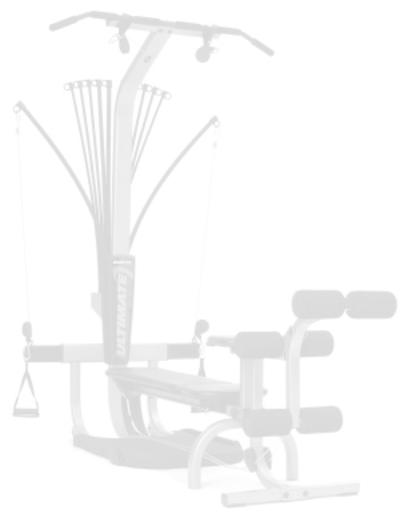
The Workouts
20 MINUTE BETTER BODY WORKOUT
FREQUENCY: 3 DAYS PER WEEK (M-W-F) TIME: ABOUT 20 MINUTES
Start by performing one set of each exercise. Warm up with a light resistance exercise that you can perform easily for 5 -10 reps without fatiguing. Focus on practicing and learning your technique before increasing the resistance. Then move to a more challenging resistance you can perform for no less than 10 reps and no more than 15 reps without your form deteriorating. As you become stronger, you can advance to two sets for each exercise. Complete all sets of each exercise before moving on to the next. Rest 30 to 45 seconds between sets. Move slowly on each rep. Use a pace that will allow you to stop the movement instantly at any point in the rep. Count three seconds up and three seconds down and work to fatigue during each set.
|
Body Part |
Exercise |
|
Sets |
Reps |
|
Chest |
Bench Press |
|
1-2 |
10-15 |
|
Back |
Seated Lat Rows |
1-2 |
10-15 |
|
|
Shoulders |
Standing Lateral Shoulder Raise |
1-2 |
10-15 |
|
|
Arms |
Standing Biceps Curl |
1-2 |
10-15 |
|
|
|
Lying Triceps Extension |
1-2 |
10-15 |
|
|
Legs |
Leg Extension |
|
1-2 |
10-15 |
|
|
Leg Curl |
|
1-2 |
10-15 |
|
|
Seated (Straight Leg) Calf Raise |
1-2 |
10-15 |
|
|
Trunk |
Low Back Extension |
1-2 |
10-15 |
|
|
|
Resisted Abdominal Crunch |
1-2 |
10-15 |
|
ADVANCED GENERAL CONDITIONING |
|
|
|
||
FREQUENCY: 4 DAYS PER WEEK (M-T-Th-F) |
TIME: ABOUT 35-45 MINUTES |
|
|||
When you are proficient in performing the exercise techniques of the above routine and are no longer realizing results, or if you become bored, it is time to change your program. You can increase your training with this “split system” routine that works opposing muscle groups on different days. To do this, you’ll increase your resistance when you can perform 12 reps perfectly, and you’ll increase your volume by performing more sets and more exercises. Move slowly on each rep. Use a pace that will allow you to stop the movement instantly at any point in the rep. Count three seconds up and three seconds down and work to fatigue during each set.
Day 1 & 3 |
Body Part |
Exercise |
Sets |
Reps |
|
Chest |
Bench Press (Wide Pulley) |
1-3 |
10-12 |
|
Shoulders |
Seated Shoulder Press |
1-3 |
10-12 |
|
Arms |
Seated Triceps Extension |
1-3 |
10-12 |
|
|
French Press |
1-3 |
10-12 |
|
Legs |
Leg Press |
1-3 |
10-12 |
|
|
Leg Curl |
1-3 |
10-12 |
|
|
Seated (Straight Leg) Calve Raise |
1-3 |
10-12 |
|
|
|
|
|
Day 2 & 4 |
Body Part |
Exercise |
Sets |
Reps |
|
Back |
Seated Lat Rows |
1-3 |
10-12 |
|
|
Narrow Pulldowns |
1-3 |
10-12 |
|
Shoulders |
Rear Deltoid Rows |
1-3 |
10-12 |
|
Arms |
Standing Biceps Curl |
1-3 |
10-12 |
|
|
Reverse Grip Barbell Curls |
1-3 |
10-12 |
|
Trunk |
Low Back Extension |
1-3 |
10-12 |
|
|
Seated Resisted Abdominal Crunch |
1-3 |
10-12 |
|
|
Reverse Crunch |
1-3 |
10-12 |
13

The Workouts
20 MINUTE UPPER/LOWER BODY
FREQUENCY: 4 DAYS PER WEEK (M-T-Th-F) |
TIME: ABOUT 20 MINUTES |
This program provides you with a quick and effective workout that combines muscle conditioning with some cardiovascular benefits. Do this routine when you are limited in time or just want a variation to your normal routine. Perform this program training 2 days, resting 1 to 2. Perform all exercises to near failure, stopping at the point that your technique starts to deteriorate. Rest only 20-30 seconds between sets. As you get stronger, increase the number of sets you perform. Move slowly on each rep. Use a pace that will allow you to stop the movement instantly at any point in the rep. Count three seconds up and three seconds down and work to fatigue during each set.
DAY 1 & 3 |
Body Part |
Exercise |
Sets |
Reps |
|
Chest |
Bench Press |
1-3 |
12-15 |
|
Back |
Wide Pulldowns |
1-3 |
12-15 |
|
Shoulders |
Standing Lateral Shoulder Raise |
1-3 |
12-15 |
|
Arms |
Standing Biceps Curl |
1-3 |
12-15 |
|
|
French Press |
1-3 |
12-15 |
|
|
|
|
|
DAY 2 & 4 |
Body Part |
Exercise |
Sets |
Reps |
|
Legs |
Leg Extension |
1-3 |
12-15 |
|
|
Seated Leg Curl |
1-3 |
12-15 |
|
|
Standing Hip Extension |
1-3 |
12-15 |
|
|
Seated (Straight Leg) Calf Raise |
1-3 |
12-15 |
|
Trunk |
Low Back Extension |
1-3 |
10-12 |
|
|
Seated Resisted Abdominal Crunch |
1-3 |
10-12 |
|
|
|
|
|
14

The Workouts
BODY BUILDING
FREQUENCY: 3 DAYS ON, 1 DAY OFF |
TIME: ABOUT 45-60 MINUTES |
Body building requires focused concentration and dedication to training, as well as proper eating habits. Train each muscle group to failure before moving on to the next exercise. Do not neglect any muscle group. If needed, include an aerobic activity to increase your caloric expenditure and help to reduce your body fat levels to achieve a defined muscular look. Rest 30-60 seconds between each set and exercise. Focus on proper form. Tighten the muscle before you move, squeeze the muscle as you move, cramp the muscle at the point of full contraction, and resist the movement as you lower the weight. Move slowly on each rep. Use a pace that will allow you to stop the movement instantly at any point in the rep. Count three seconds up and three seconds down and work to fatigue during each set.
DAY 1 |
Body Part |
Exercise |
Sets |
Reps |
|
Chest |
Bench Press (Wide Pulley) |
2-4 |
8-12 |
|
|
Chest Fly |
2-4 |
8-12 |
|
Shoulders |
Seated Shoulder Press |
2-4 |
8-12 |
|
|
Rear Deltoid Rows |
2-4 |
8-12 |
|
|
Standing Lateral Shoulder Raise |
2-4 |
8-12 |
|
|
Shoulder Shrug |
2-4 |
8-12 |
|
|
|
|
|
DAY 2 |
Body Part |
Exercise |
Sets |
Reps |
|
Back |
Seated Lat Rows |
2-4 |
8-12 |
|
|
Narrow Pulldowns |
2-4 |
8-12 |
|
Arms |
Standing Biceps Curl |
2-4 |
8-12 |
|
|
Reverse Grip Barbell Curls |
2-4 |
8-12 |
|
|
Lying Triceps Extension |
2-4 |
8-12 |
|
|
French Press |
2-4 |
8-12 |
|
|
|
|
|
DAY 3 |
Body Part |
Exercise |
Sets |
Reps |
|
Legs |
Leg Press |
2-4 |
8-12 |
|
|
Leg Extension |
2-4 |
8-12 |
|
|
Standing Hip Extension |
2-4 |
8-12 |
|
|
Leg Curl |
1-3 |
8-12 |
|
|
Seated (Straight Leg) Calf Raise |
2-4 |
12-15 |
|
Trunk |
Low Back Extensions |
2-4 |
8-12 |
|
|
Seated Resisted Abdominal Crunch |
2-4 |
8-12 |
|
|
Seated Resisted Oblique Crunch |
2-4 |
8-12 |
|
|
Aerobic Rowing |
Progress up to |
|
|
|
|
15-25 minutes |
|
|
|
|
|
|
15
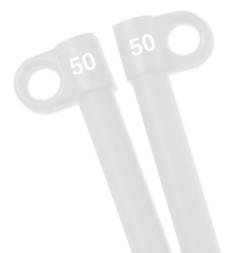
The Workouts
CIRCUIT TRAINING - ANAEROBIC/CARDIOVASCULAR
FREQUENCY: 2-3 TIMES PER WEEK |
TIME: ABOUT 20-45 MINUTES |
Circuit training is a great way to achieve the benefits of strength training and cardiovascular training in one quick, challenging routine. The idea is to move quickly from exercise to exercise, taking only as much rest between sets as it takes to set up the next exercise (less than 20 seconds). One circuit equals one set of each exercise. Initially, start with completing one round of Circuit 1. Then add an additional round of the same circuit. Once you reach three rounds of Circuit 1, add one round of Circuit 2. Add additional rounds of Circuit 2 as your fitness level increases. Repeat process with Circuit 3. Do not let your heart rate exceed 220 minus your age. Perform each rep of each exercise slowly and with perfect technique. Count three seconds up and three seconds down. Warm-up with 5-15 minutes of rowing or some other aerobic exercise before starting your circuits.
Circuit 1 |
Body Part |
Exercise |
Reps |
|
Chest |
Bench Press |
8-12 |
|
Legs |
Leg Press |
8-12 |
|
Back |
Seated Lat Row |
8-12 |
|
Legs |
Seated Leg Curl |
8-12 |
|
Trunk |
Seated Resisted Abdominal Crunch |
8-12 |
|
|
|
|
Circuit 2 |
Body Part |
Exercise |
Reps |
|
Shoulders |
Seated Shoulder Press |
8-12 |
|
Legs |
Lying Leg Extension |
8-12 |
|
Back |
Lying Lat Pulldowns |
8-12 |
|
Trunk |
Low Back Extensions |
8-12 |
|
Arms |
Standing Biceps Curl |
8-12 |
|
|
|
|
Circuit 3 |
Body Part |
Exercise |
Reps |
|
Shoulders |
Rear Deltoid Rows |
8-12 |
|
Arms |
Lying Triceps Extensions |
8-12 |
|
Legs |
Leg Curls |
8-12 |
|
Trunk |
Seated Resisted Oblique Crunch |
8-12 |
|
Legs |
Seated (Straight Leg) Calf Raise |
8-12 |
|
|
|
|
16
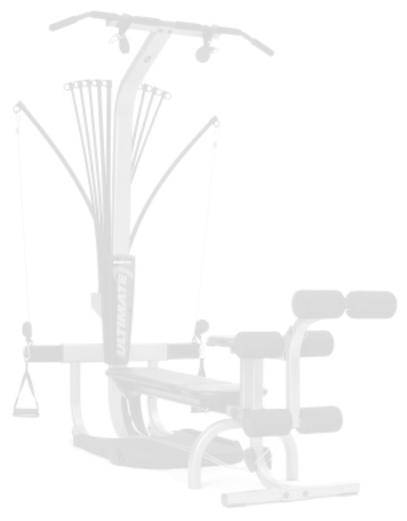
The Workouts
TRUE AEROBIC CIRCUIT TRAINING
FREQUENCY: 2-3 TIMES PER WEEK |
TIME: ABOUT 20-60 MINUTES |
Circuit training is a great way to achieve the benefits of strength training and cardiovascular training in one quick, challenging routine. By returning to the aerobic rowing exercise between each set you are increasing your aerobic capacity, endurance and burning fat as energy. The idea is to move quickly from exercise to exercise, taking only as much rest between sets as it takes to set up the next exercise (less than 20 seconds). One circuit equals one set of each exercise. Initially, start with completing one round of Circuit 1. Then add an additional round of the same circuit. Once you reach three rounds of Circuit 1, add one round of Circuit 2. Add additional rounds of Circuit 2 as your fitness level increases. Repeat process with Circuit 3. Do not let your heart rate exceed 220 minus your age. Perform each rep of each exercise slowly and with perfect technique. Count three seconds up and three seconds down. Warm-up with 5-15 minutes of rowing or some other aerobic exercise before starting your circuits.
Circuit 1 |
Body Part |
Exercise |
Reps |
|
Chest |
Bench Press |
8-12 |
|
Aerobic Rowing |
30 - 60 Seconds |
|
|
Legs |
Leg Press |
8-12 |
|
Aerobic Rowing |
30 - 60 Seconds |
|
|
Back |
Seated Lat Rows |
8-12 |
|
Aerobic Rowing |
30 - 60 Seconds |
|
|
Legs |
Seated Leg Curl |
8-12 |
|
Aerobic Rowing |
30 - 60 Seconds |
|
|
Trunk |
Seated Resisted Abdominal Crunch |
8-12 |
|
Aerobic Rowing |
30 - 60 Seconds |
|
|
|
|
|
Circuit 2 |
Body Part |
Exercise |
Reps |
|
Shoulders |
Seated Shoulder Press |
8-12 |
|
Aerobic Rowing |
30 - 60 Seconds |
|
|
Legs |
Lying Leg Extension |
8-12 |
|
Aerobic Rowing |
30 - 60 Seconds |
|
|
Back |
Lying Lat Pulldowns |
8-12 |
|
Aerobic Rowing |
30 - 60 Seconds |
|
|
Trunk |
Low Back Extension |
8-12 |
|
Aerobic Rowing |
30 - 60 Seconds |
|
|
Arms |
Standing Biceps Curl |
8-12 |
|
|
|
|
17

The Workouts
STRENGTH TRAINING
FREQUENCY: 3 DAYS PER WEEK (M-W-F) TIME: ABOUT 45-60 MINUTES
This program is designed to emphasize overall strength development. This is an advanced routine to be used only after you have progressed from the advanced general conditioning routine and only after you have perfected your exercise techniques. Work each set to near exhaustion. If you can perform more than 5 to 8 reps, you should increase your resistance 5 lbs. and decrease your reps to 5. Rest 60 - 120 seconds between each set and exercise. Focus on proper form. Tighten the muscle before you move, squeeze the muscle as you move, cramp the muscle at the point of full contraction, and resist the movement as you lower the weight. Move slowly on each rep. Use a pace that will allow you to stop the movement instantly at any point in the rep. Count two seconds up and four seconds down and work to fatigue during each set.
Day 1 |
Body Part |
Exercise |
Sets |
Reps |
|
Chest |
Bench Press (wide pulley) |
2-4 |
5-8 |
|
|
Chest Fly (wide pulley) |
2-4 |
5-8 |
|
Shoulders |
Seated Shoulder Press |
2-4 |
5-8 |
|
|
Standing Lateral Shoulder Raise |
2-4 |
5-8 |
|
|
Rear Deltoid Rows |
2-4 |
5-8 |
|
|
Shoulder Shrug |
2-4 |
5-8 |
|
|
|
|
|
Day 2 |
Body Part |
Exercise |
Sets |
Reps |
|
Back |
Barbell Bent Over Row |
2-4 |
5-8 |
|
|
Wide Pulldowns |
2-4 |
5-8 |
|
Arms |
Standing Biceps Curl |
2-4 |
5-8 |
|
|
Reverse Grip Barbell Curls |
2-4 |
5-8 |
|
|
Seated Triceps Extension |
2-4 |
5-8 |
|
|
Standing Triceps Pushdown |
2-4 |
5-8 |
Day 3 |
Body Part |
Exercise |
Sets |
Reps |
|
Legs |
The Squat |
2-4 |
5-8 |
|
|
Lying Prone Leg Curl |
2-4 |
5-8 |
|
|
Seated Leg Curl |
2-4 |
5-8 |
|
|
Seated (Straight Leg) Calf Raise |
2-4 |
5-8 |
|
Trunk |
Low Back Extension |
2-4 |
8-12 |
|
|
Seated Resisted Abdominal Crunch |
2-4 |
5-8 |
|
|
|
|
|
18

Chest Exercises
BENCH PRESS — Shoulder Horizontal Adduction (and elbow extension)
Muscles worked: This exercise emphasizes the chest muscles (pectoralis major). It also involves the front shoulder muscles (anterior deltoid, a portion of the middle deltoid) and the triceps, which are located on the back of the upper arm.
Pulley position: Wide or narrow (Wide offers a greater challenge throughout the entire range on specific movements, especially at the top of these movements. This can make these exercises even more effective. However, when both pulley positions are listed as options, do not attempt to use the same weight for each position).
Starting Position:
•Seated in the 45 degree position, reach straight behind your body, grasp the handles, and bend your elbows until your hands are near your chest. Rotate your upper arms away from your torso so your elbows are pointing outward and your palms are facing forward.
•Keeping knees bent and feet flat on the floor, lay your head back against the bench and straighten your arms to the front.
•Be sure your arms are directly "in line" with the cables (cables lying along the backs of your arms and center of the shoulders), palms facing forward and wrists straight.
•Raise your chest and slightly "pinch" your shoulder blades together. Maintain a very slight, comfortable arch in your lower back.
Motion:
•Slowly move your elbows outward while simultaneously bending your arms so your forearms remain parallel to each other and
the hands remain over the elbows throughout the movement. From the side view it would appear as if the forearms are in-line with the cables at all times.
•Stop when your upper arms are approximately straight out to the side (your elbows will be level with your shoulders or slightly below).
•Then, slowly press forward, moving hands toward the center. Return to starting position with arms straight to the front at shoulder width and in-line with the cables. Keep chest muscles tight during the entire motion.
Optional motions:
•Bilateral movement - both arms pressing forward at the same time.
•Unilateral movement – performing all reps with one arm before moving to the next.
•Alternating – performing one rep on one side and then the next rep on the other side.
•Simultaneously alternating – both arms moving, although in opposite directions (one pressing while the other is returning)
Key points:
•The upper arms will be 60-90 degrees from the sides of your torso at the bottom of the movement and approximately 90 degrees from the front of your torso at the top.
•Control the range of motion so your elbows travel only slightly behind your shoulders.
•Your shoulder blades may "float" forward and backward naturally with the arm movement. For increased pec involvement, keep the shoulder blades "pinched" together throughout both the upward and downward movements.
CHEST FLY — Shoulder Horizontal Adduction (elbow stabilized in slight flexion)
Muscles worked: This exercise emphasizes the chest muscles (pectoralis major). It also involves the front shoulder muscles (anterior deltoid).
Pulley position: Wide or narrow (Wide offers a greater challenge throughout the entire range on specific movements, especially at the top of these movements. This can make these exercises even more effective. However, when both pulley positions are listed as options, do not attempt to use the same weight for each position).
Motion:
•Slowly move your arms outward, maintaining the elbow in a slightly bent position throughout the movement.
•Stop when your upper arms are approximately straight out to the sides (your elbows will be level with your shoulders or very slightly below).
•Slowly return to starting position keeping your chest muscles tightened during the entire motion.
Key points:
Starting position:
•Seated in the 45 degree position, reach straight behind your body, grasp the handles, and bend your elbows until your hands are near your chest. Rotate your upper arms away from your torso so that your elbows are pointing outward at each side and your palms are facing forward.
•Keeping knees bent and feet flat on the floor, lay your head back against the bench and straighten your arms to the front.
•Be sure that your arms are directly "in line" with the cables, palms facing forward and wrists straight.
•Raise your chest and slightly "pinch" your shoulder blades together. Maintain a very slight, comfortable arch in your lower back.
•Maintain a 60-90 degree angle between the upper arms and the torso throughout the exercise.
•Limit and control the range of motion so that your elbows travel only slightly behind your shoulders if at all.
•For normal pressing/pushing patterns of movement, your shoulder blades may "float" forward and backward naturally with the arm movement. For increased pec involvement, keep the shoulder blades "pinched" together throughout both the upward and downward movements.
START
FINISH
START
FINISH
19

Chest Exercises
INCLINE BENCH PRESS — Shoulder Horizontal Adduction (with elbow extension)
Muscles worked: This exercise emphasizes the chest muscles (pectoralis major), especially the upper portion. It also involves the front shoulder muscles (anterior deltoid, a portion of the middle deltoid) and the triceps, which are located on the back of the upper arm.
Pulley position: Wide or narrow (Wide offers a greater challenge throughout the entire range on specific movements, especially at the top of these movements. This can make these exercises even more effective. However, when both pulley positions are listed as options, do not attempt to use the same weight for each position).
Starting position:
•Seated in the 45 degree position, reach straight behind your body, grasp the handles, and bend your elbows until your hands are near your chest. Rotate your upper arms away from your torso so that your elbows are pointing outward to each side and your palms are facing forward.
•Keeping knees bent and feet flat on the floor, lay your head back against the bench and straighten your arms to the front.
•You may also utilize the alternate incline bench press position by placing your feet on the forward leg of the Bowflex and using your legs to slide the torso upward on the bench so that your head is near the lat tower. This will allow a greater incline of the arms without losing alignment of the cables.
•From this position, raise your arms 10-15 degrees (cables touching the tops of your arms/shoulders) above the regular bench press position (cables lying along the backs of your arms and center of the shoulders).
•Be sure that your arms are directly "in line" with the cables, palms facing forward and wrists straight. If the cables are "above" the arms, too much elevation was introduced.
•Raise your chest and slightly "pinch" your shoulder blades together. Maintain a very slight, comfortable arch in your lower back.
Motion:
•Slowly move your elbows outward, simultaneously bending your arms so that your forearms remain parallel to each other and the hands remain over the elbows throughout the movement. From the side view it should appear as if the forearms are in line with the cables at all times.
•Stop when your upper arms are approximately straight out to the sides (your elbows will be level with your shoulders or very slightly below).
•Then, slowly press forward/upward, moving hands toward the center. Then return to starting position with arms straight to the front at shoulder width and in-line with the cables. Keep your chest muscles tightened during the entire motion.
Optional motions:
•Bilateral movement - both arms pressing forward at the same time.
•Unilateral movement – performing all reps with one arm before moving to the next.
•Alternating – performing one rep on one side and then the next rep on the other side.
•Simultaneously alternating – both arms moving, although in opposite directions (one pressing while the other is returning).
Key points:
•The upper arms will be 60-90 degrees from the sides of your torso at the bottom of the movement and slightly more than 90 degrees from the front of your torso at the top.
•Limit and control the range of motion so that your elbows travel only slightly behind your shoulders — if at all.
•For normal pressing/pushing patterns of movement you may choose to allow the shoulder blades to "float" forward and backward naturally with the arm movement, or for increased pec involvement you may keep the shoulder blades "pinched" together throughout both the upward and downward movements.
START
FINISH
20

Chest Exercises
DECLINE BENCH PRESS - Shoulder Horizontal Adduction (with elbow extension)
Muscles worked: The entire chest muscle (pectoralis major) is emphasized. It also involves the front shoulder muscles (anterior deltoid, a portion of the middle deltoid) and the triceps, which are located on the back of the upper arms.
Pulley position: Wide or narrow (Wide offers a greater challenge throughout the entire range on specific movements, especially at the top of these movements. This can make these exercises even more effective. However, when both pulley positions are listed as options, do not attempt to use the same weight for each position).
Starting position:
•Seated in the incline position, reach straight behind your body, grasp the handles with an overhand grip and bend your elbows until your hands are near your chest. Rotate upper arms away from your torso so your elbows point outward and your palms face forward.
•Make sure cables travel underneath your arms, not over your arms.
•Keeping knees bent and feet flat on the floor, lay your head back against the bench and straighten your arms to the front.
•From this position, lower your arms 10-15 degrees (cables touching the bottom of your arms/shoulders) below the regular bench press position (cables lying along the back of your arm and center of the shoulders).
•Be sure your arms are directly in-line with the cables, palms facing forward and wrists straight. If the cables are "below" the arms, the arms are too low.
•Raise your chest and slightly "pinch" your shoulder blades together. Maintain a very slight, comfortable arch in your lower back.
Motion:
•Slowly move your elbows outward, simultaneously bending your arms so that your forearms remain parallel to each other and the hands remain over the elbows throughout the movement. From the side view it should appear as if the forearms are in line with the cables at all times.
•Stop when your upper arms are approximately straight out to the sides (your elbows will be level with your shoulders or slightly below).
•Then, slowly press forward, moving the hands toward the center, and return to the starting position with arms straight to the front at shoulder width and in line with the cables. Keep your chest muscles tightened during the entire motion.
Optional motions:
•Bilateral movement - both arms pressing forward at the same time.
•Unilateral movement – performing all reps with one arm before moving to the next.
•Alternating – performing one rep on one side and then the next rep on the other side.
•Simultaneously alternating – both arms moving, although in opposite directions (one pressing while the other is returning).
Key points:
•The upper arms will be 60-90 degrees from the sides of your torso at the bottom of the movement and slightly less than 90 degrees from the front of your torso at the top.
•Limit the range of motion so your elbows travel only slightly behind your shoulders — if at all.
RESISTED PUNCH — Shoulder Flexion, Elbow Extension and Scapular Protraction
Muscles worked: This exercise involves the entire chest muscle, the front shoulder muscles (anterior deltoid, a portion of the middle deltoid) and the triceps, located on the back of the upper arms. The goal however, is not any specific muscle group. It is to be used with very light resistance for an endurance activity.
Pulley position: Narrow only.
Starting position:
•With the bench flat and locked in the back position against the lat tower, sit facing away from the Power Rods®.
•Reach straight behind your body, grasp the handles with an overhand grip so that the cable will lay between your arm and your torso.
•Bend your elbows until your hands are level with your waistline and your palms are facing your torso.
•Maintain erect posture.
Motion:
•Using a moderate speed and light weight, rotate your trunk and press one arm forward to full extension, allowing the shoulder blade to move forward at the end of the punch.
•Return that arm to the starting position — under control — and repeat with the other arm.
•As an alternative to punching straight forward you may also punch upward at an angle in line with the cable.
Optional motions:
•Bilateral movement – both arms pressing forward at the same time.
•Unilateral movement – performing all reps with one arm before moving to the next.
•Alternating – performing one rep on one side and then the next rep on the other side.
•Simultaneously alternating – both arms moving, although in opposite directions (one pressing while the other is returning).
Key points:
•Maintain an upright, erect posture as your trunk twists/rotates with the punch.
•It is important to note that "sport specific" movements will not necessarily improve the skill associated with a sport.
START
FINISH
START
FINISH
21
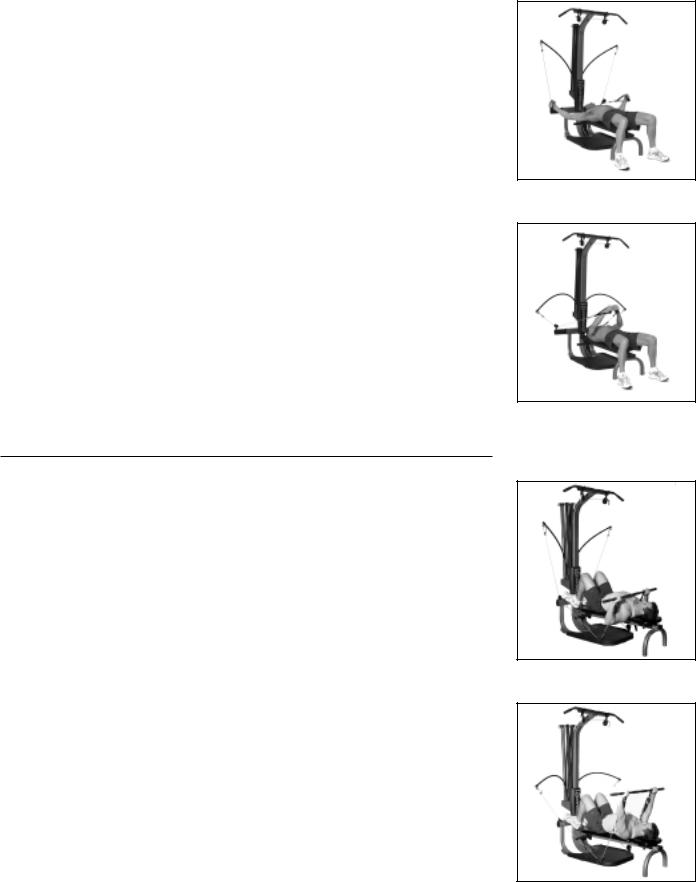
Chest Exercises
LYING CABLE CROSSOVER — Shoulder extension/adduction (elbow stabilized near extension)
Muscles worked: This exercise emphasizes the chest (the pectoralis major muscles). The triceps muscles, located on the back of the upper arms, are also involved in maintaining the elbow position and also help with shoulder motion.
Pulley position: Wide only.
Starting position:
•With the bench flat, lie on your back with your head toward the Power Rods. Position yourself far enough down the bench to allow the arms to extend overhead without hitting the Power Rods. Keep the knees bent and feet flat on the floor.
•Extend the arms overhead and grasp the handles with your palms facing the ceiling.
•Tighten your abdominals to stabilize your spine while maintaining a very slight arch in the lower back.
Motion:
•Move your hands in an arc upward angling toward midline and then downward toward the opposite leg.
•Control the return to the starting position by slowly moving the arms back up, uncrossing, and moving overhead.
Key points:
•Keep your chest lifted, even as your arms near your legs.
FLAT BARBELL BENCH PRESS
Muscles worked: This exercise emphasizes the chest muscles (pectoralis major). It also involves the front shoulder muscles (anterior deltoid, a portion of the middle deltoid) and the triceps, which are located on the back of the upper arm.
Pulley position: Low pulleys only.
Starting Position:
•Begin by adjusting the bar harness so that you are under tension when you initiate the pressing motion. NOTE: Not everyone is built to perform the bench press with the bar touching the chest! The harness adjustment should limit the range of motion so that your elbows travel only slightly behind your shoulders if at all.
•Lie flat on the bench with your legs toward the power rod. Slide your head and shoulders up under the bar to get into position. The cable/bar harness should lie against the underside of your arms.
•Warning: Never adjust the bar so tightly that you have to "squeeze under it" to get into position. Always adjust the bar with the harness so you can move freely into and out of the position.
•Place your feet either on the floor or up on the frame of the machine.
•Position your upper arms away from your torso so that your elbows are pointing out at each side.
•Raise your chest and slightly "pinch" your shoulder blades together. Maintain a very slight, comfortable arch in your lower back.
Motion:
•Slowly press the bar upward until your upper arms are straight, but do not lock the elbows.
•Slowly lower the bar, returning to the starting position.
•Keep your chest muscles tightened during the entire motion.
Key points:
•Do not lift your hips off the bench.
•Keep your hands over your shoulders at all times.
•For normal pressing/pushing patterns of movement you may choose to allow the shoulder blades to "float" forward and backward naturally with the arm movement, or for increased pec involvement you may keep the shoulder blades "pinched" together throughout both the upward and downward movements.
START
FINISH
START
FINISH
22
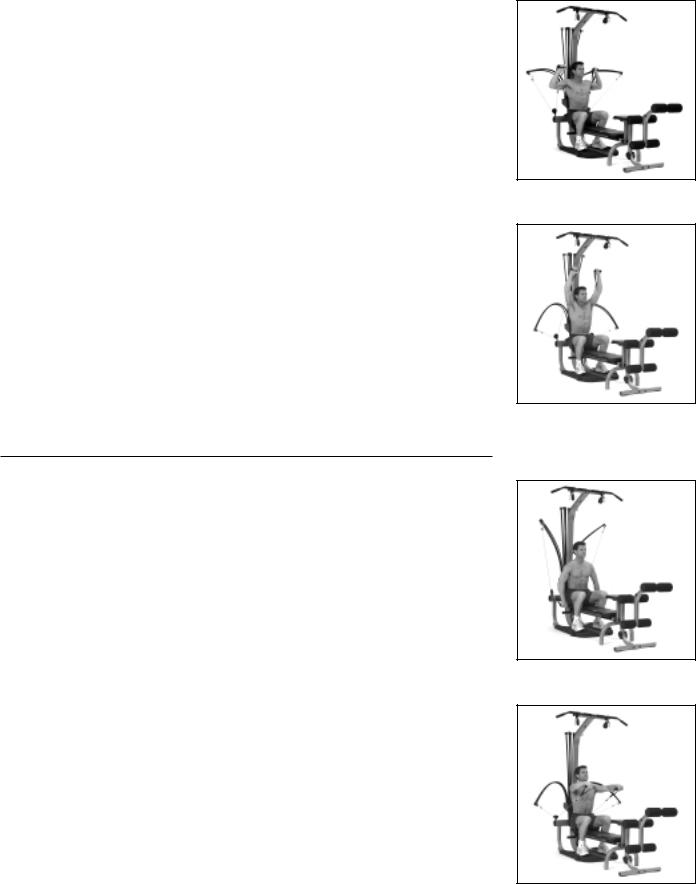
Shoulder Exercises
SEATED SHOULDER PRESS — Shoulder Abduction (with elbow extension)
Muscles worked: This exercise emphasizes the front portion of the shoulder muscles (front deltoids as well as the front part of the middle deltoids), the rotator cuff muscles, the upper back muscles (trapezius), and the triceps muscles located on the back of the upper arms.
Pulley position: Wide or narrow (Wide offers a greater challenge throughout the entire range on specific movements, especially at the top of these movements. This can make these exercises even more effective. However, when both pulley positions are listed as options, do not attempt to use the same weight for each position).
Starting position:
•Sit on the bench facing away from the Power Rods, knees bent and feet flat on the floor.
•You may sit back against the lat tower, or you may choose to sit forward away from the tower and remaining free from back support, thereby increasing the challenge of spinal stabilization as part of the exercise.
•Keep your chest up, abdominals tight and maintain a very slight arch in your lower back.
•Grasp the handles with palms facing away from the machine.
•Raise handles to just above shoulder level, keeping palms facing forward.
Motion:
•Straighten the arms upward, focusing on a final point either directly overhead or slightly forward over the forehead as comfort/shoulder range dictates.
•Slowly return to starting position keeping tension in the front shoulder muscles.
Optional motions:
•Bilateral movement - both arms pressing at the same time.
•Unilateral movement – performing all reps with one arm before moving to the next.
•Alternating – performing one rep on one side and then the next rep on the other side.
•Simultaneously alternating – both arms moving, although in opposite directions (one pressing while the other is returning).
Key points:
•Keep the chest up and abdominals tight throughout the entire motion to maintain good spinal alignment.
•Do not let the arch increase in the lower back while pressing up.
FRONT SHOULDER PRESS — Shoulder Flexion (elbow stabilized near extension)
Muscles worked: This exercise emphasizes the front portion of the shoulder muscles (front deltoids as well as the front part of the middle deltoids).
Pulley position: Narrow only.
Starting position:
•Sit on the bench facing away from the Power Rods, knees bent and feet flat on the floor.
•You may sit back against the lat tower, or you may choose to sit forward away from the tower and remaining free from support, thereby increasing the challenge of spinal stabilization as part of the exercise.
•Keep your chest up, abdominals tight and maintain a slight arch in your lower back.
•Grasp handles with your palms facing backward and arms straight at your sides.
Motion:
•Keeping your arms straight and your palms down, move your arms forward and then upward to shoulder height.
•Slowly return the arms beside the torso and repeat.
Optional motions:
•Bilateral movement - both arms raising at the same time.
•Unilateral movement – performing all reps with one arm before moving to the next.
•Alternating – performing one rep on one side and then the next rep on the other side.
•Simultaneously alternating – both arms moving, although in opposite directions (one raising while the other is returning).
Key points:
•Keep the chest lifted and the abdominals tightened throughout the entire motion and maintain good spinal alignment.
•Do not increase the arch in your lower back while lifting your arms.
START
FINISH
START
FINISH
23
